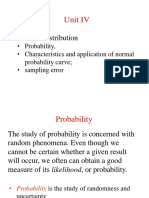Probability Theory: Much Inspired by The Presentation of Kren and Samuelsson
Uploaded by
duylinh65Probability Theory: Much Inspired by The Presentation of Kren and Samuelsson
Uploaded by
duylinh65Probability theory
Much inspired by the presentation of
Kren and Samuelsson
3 view of probability
Frequentist
Mathematical
Bayesian (knowledge-based)
Sample space
A universe of elementary outcomes. In
elementary treatments, we pretend that we
can come up with sets of equiprobable
outcomes (dice, coins, ...). Outcomes are
very small.
An event is a set of those outcomes. Events
are bigger than outcomes -- more
interesting.
Probability measure
Every event (=set of outcomes) is assigned
a probability, by a function we call a
probability measure.
The probability of every set is between 0
and 1, inclusive.
The probability of the whole set of
outcomes is 1.
If A and B are two event with no common
outcomes, then the probability of their
union is the sum of their probabilities.
Cards
Out universe of outcomes is single card
pulls.
Events: a red card (1/2); a jack (1/13);
Other things to remember
The probability that event P will not happen
(=event ~P will happen) is 1-prob(P).
Prob (null outcome) = 0.
p ( A B ) = p(A) + p(B) - p( A B).
Independence (definition)
Two events A and B are independent if the
probability of AB = probability of A times
the probability of B (that is, p(A)* p(B) ).
Conditional probability
This means: what's the probability of A if I
already know B is true?
p(A|B) = p(A and B) / p (B) =
p(A B) / p(B)
Probability of A given B.
p(A) is the prior probability; p(A|B) is called
a posterior probability. Once you know B is
true, the universe you care about shrinks to
B.
Bayes' rule
prob (A and B) = prob (B and A); so
prob (A |B) prob (B) = prob (B|A) prob (A)
-- just using the definition of prob (X|Y));
hence
) (
) ( ) | (
) | (
B prob
A prob A B prob
B A prob =
Bayes rule as scientific
reasoning
A hypothesis H which is supported by a set
of data D merits our belief to the degree
that:
1. We believed H before we learned about
D;
2. H predicts data D; and
3. D is unlikely.
A random variable
a.k.a. stochastic variable.
A random variable isn't a variable. It's a
function. It maps from the sample space to
the real numbers. This is a convenience: it is
our way of translating events (whatever
they are) to numbers.
Distribution function
Distribution function:
This is a function that takes a real number x
as its input, and finds all those outcomes in
the sample space that map onto x or
anything less than x.
For a die, F(0) = 0; F(1) = 1/6; F(2) = 1/3;
F(3) = 1/2; F(4) = 2/3; F(5) = 5/6; and F(6)
= F(7) = 1.
discrete distribution function
discrete, continuous
If the set of values that the distribution
function takes on is finite, or countable,
then the random variable (which isn't a
variable, it's a function) is discete; otherwise
it's continuous (also, it ought to be mostly
differentiable).
Distribution function aggregates
It's a little bit counterintuitive, in a way. What
about a function P for a die that tells us that P (
1) = 1/6, P(2) = 1/6, ... p(6) = 1/6?
That's a frequency function, or probability
function. We'll use the letter f for this. For the
case of continuous variables, we don't want to
ask what the probability of "1/6" is, because the
answer is always 0...
Rather, we ask what's the probability that
the value is in the interval (a,b) -- that's OK.
So for continuous variables, we care about
the derivative of the distribution function at
a point (that's the derivative of an integral,
after all...). This is called a probability
density function. The probability that a
random variable has a value in a set A is the
integral of the p.d.f. over that set A.
Frequency function f
The sum of the values of the frequency
function f must add up to 1!
The integral of the probability density
function must be 1.
A set of numbers that adds up to 1 is called
a distribution.
Means that have nothing to do
with meaning
The mean is the average; in everyday terms, we
add all the values and divide by the number of
items. The symbol is 'E', for 'expected' (why is the
mean expected? What else would you expect?)
Since the frequency function f tells you how many
there are of any particular value, the mean is
i
i i
x f x ) (
Weight a moment...
The mean is the first moment; the second moment is
the variance, which tells you how much the random
variable jiggles. It's the sum of the differences from
the mean (square those differences so they're
positive). The square root of this is the standard
deviation. (We don't divide by N here; that's inside
the f-function, remember?)
i
i i
x f x ) ( ) (
2
Particular probability
distributions:
Binomial
Gaussian, also known as normal
Poisson
Binomial distribution
If we run an experiment n times
(independently: simultaneous or not, we
don't care), and we care only about how
many times altogether a particular outcome
occurs -- that's a binomial distribution, with
2 parameters: the probability p of that
outcome on a single trial, and n the number
of trials.
If you toss a coin 4 times, what's the
probability that you'll get 3 heads?
If you draw a card 5 times (with
replacement), what's the probability that
you'll get exactly 1 ace?
If you generate words randomly, what's the
probability that you'll have two the's in the
first 10 words?
In general, the answer is
k n k k n k
q p
k k n
n
q p
k
n
=
|
.
|
\
|
! )! (
!
Normal or Gaussian distribution
Start off with something simple, like this:
2
x
e
That's symmetric around the y-axis (negative and
positive x treated the same way -- if x = 0, then the
value is 1, and it slides to 0 as you go off to infinity,
either positive or negative.
Gaussian or normal distribution
Well, x's average can be something other
than 0: it can be any old
2
) ( x
e
2
2
2
) (
o
x
e
And its variance (o
2
) can be other than 1
And then normalize--
so that it all adds up (integrates, really) to 1,
we have to divide by a normalizing factor:
2
2
2
) (
2
1
o
t o
x
e
You might also like
- "Perfwall" - Perforated Wood Shear Wall Analysis: Program DescriptionNo ratings yet"Perfwall" - Perforated Wood Shear Wall Analysis: Program Description3 pages
- Statistical Methods in Quality ManagementNo ratings yetStatistical Methods in Quality Management71 pages
- ML_Lec 2- Review of probability and statisticsNo ratings yetML_Lec 2- Review of probability and statistics30 pages
- Intro To Probability (Pattern Recognition)No ratings yetIntro To Probability (Pattern Recognition)94 pages
- Random Variables: Petter Mostad 2005.09.19No ratings yetRandom Variables: Petter Mostad 2005.09.1924 pages
- BIOSTAT Random Variables & Probability DistributionNo ratings yetBIOSTAT Random Variables & Probability Distribution37 pages
- Imprecise Probability in Risk Analysis (PDFDrive) PDFNo ratings yetImprecise Probability in Risk Analysis (PDFDrive) PDF48 pages
- ProbabilityDistributions_BRSM_SP2022_Lecture3No ratings yetProbabilityDistributions_BRSM_SP2022_Lecture345 pages
- OpenStax Statistics CH04 LectureSlides - IsuNo ratings yetOpenStax Statistics CH04 LectureSlides - Isu48 pages
- Unit 03 - Random Variables - 1 Per PageNo ratings yetUnit 03 - Random Variables - 1 Per Page47 pages
- A (Very) Brief Review of Statistical Inference: 1 Some PreliminariesNo ratings yetA (Very) Brief Review of Statistical Inference: 1 Some Preliminaries9 pages
- Blue White Abstract Simple Project Presentation _20240804_193747_0000No ratings yetBlue White Abstract Simple Project Presentation _20240804_193747_000016 pages
- Notes 5 - Binomial and Geometric Probability DistributionsNo ratings yetNotes 5 - Binomial and Geometric Probability Distributions9 pages
- Statistical Foundations: SOST70151 - LECTURE 2No ratings yetStatistical Foundations: SOST70151 - LECTURE 243 pages
- Instructions For Chapter 5-By Dr. Guru-Gharana The Binomial Distribution Random VariableNo ratings yetInstructions For Chapter 5-By Dr. Guru-Gharana The Binomial Distribution Random Variable10 pages
- Statistical Methods in Quality ManagementNo ratings yetStatistical Methods in Quality Management71 pages
- Unit 5 - Probability Theory For Financial RiskNo ratings yetUnit 5 - Probability Theory For Financial Risk74 pages
- BPT-Probability-binomia Distribution, Poisson Distribution, Normal Distribution and Chi Square TestNo ratings yetBPT-Probability-binomia Distribution, Poisson Distribution, Normal Distribution and Chi Square Test41 pages
- Part IA - Probability: Based On Lectures by R. WeberNo ratings yetPart IA - Probability: Based On Lectures by R. Weber78 pages
- Cpts 440 / 540 Artificial Intelligence: Uncertainty ReasoningNo ratings yetCpts 440 / 540 Artificial Intelligence: Uncertainty Reasoning59 pages
- Statistics and Probability Reviewer Quarter 3No ratings yetStatistics and Probability Reviewer Quarter 319 pages
- Dealing With Uncertainty P (X - E) : Probability Theory The Foundation of StatisticsNo ratings yetDealing With Uncertainty P (X - E) : Probability Theory The Foundation of Statistics34 pages
- MODULE 1 - Random Variables and Probability DistributionsNo ratings yetMODULE 1 - Random Variables and Probability Distributions12 pages
- Chapter 3 - Special Probability DistributionsNo ratings yetChapter 3 - Special Probability Distributions45 pages
- Edexcel GCE: 6664/01 Core Mathematics C2 Advanced SubsidiaryNo ratings yetEdexcel GCE: 6664/01 Core Mathematics C2 Advanced Subsidiary7 pages
- On A Strengthened Hardy-Hilbert Inequality - Bicheng YangNo ratings yetOn A Strengthened Hardy-Hilbert Inequality - Bicheng Yang14 pages
- Edexcel GCE: 6665/01 Core Mathematics C3 Advanced LevelNo ratings yetEdexcel GCE: 6665/01 Core Mathematics C3 Advanced Level7 pages
- Is There Something That Bothers or Preoccupies You?No ratings yetIs There Something That Bothers or Preoccupies You?13 pages
- The Carleman'S Inequality For Negative Power Number: Nguyen Thanh Long, Nguyen Vu Duy LinhNo ratings yetThe Carleman'S Inequality For Negative Power Number: Nguyen Thanh Long, Nguyen Vu Duy Linh7 pages
- SAP BW Testing Episode 1 - Introduction: 1 PrerequistsNo ratings yetSAP BW Testing Episode 1 - Introduction: 1 Prerequists6 pages
- Numerical Solution To The Laplace EquationNo ratings yetNumerical Solution To The Laplace Equation8 pages
- Historical Development of Hand Gesture Recognition: 2.1 History of Data GloveNo ratings yetHistorical Development of Hand Gesture Recognition: 2.1 History of Data Glove11 pages
- Lab Assignment 5 19BCE2470 Samridhi Jhijaria: 5.1 - Program To Display Numbers in LED DisplayNo ratings yetLab Assignment 5 19BCE2470 Samridhi Jhijaria: 5.1 - Program To Display Numbers in LED Display9 pages
- IT 18 - Social and Professional Issues Module 3100% (1)IT 18 - Social and Professional Issues Module 32 pages
- As NZS 4266.16-2004 Reconstituted Wood-Based Panels - Methods of Test Formaldehyde Emission - Desiccator MethNo ratings yetAs NZS 4266.16-2004 Reconstituted Wood-Based Panels - Methods of Test Formaldehyde Emission - Desiccator Meth2 pages
- "Perfwall" - Perforated Wood Shear Wall Analysis: Program Description"Perfwall" - Perforated Wood Shear Wall Analysis: Program Description
- BIOSTAT Random Variables & Probability DistributionBIOSTAT Random Variables & Probability Distribution
- Imprecise Probability in Risk Analysis (PDFDrive) PDFImprecise Probability in Risk Analysis (PDFDrive) PDF
- A (Very) Brief Review of Statistical Inference: 1 Some PreliminariesA (Very) Brief Review of Statistical Inference: 1 Some Preliminaries
- Blue White Abstract Simple Project Presentation _20240804_193747_0000Blue White Abstract Simple Project Presentation _20240804_193747_0000
- Notes 5 - Binomial and Geometric Probability DistributionsNotes 5 - Binomial and Geometric Probability Distributions
- Instructions For Chapter 5-By Dr. Guru-Gharana The Binomial Distribution Random VariableInstructions For Chapter 5-By Dr. Guru-Gharana The Binomial Distribution Random Variable
- BPT-Probability-binomia Distribution, Poisson Distribution, Normal Distribution and Chi Square TestBPT-Probability-binomia Distribution, Poisson Distribution, Normal Distribution and Chi Square Test
- Part IA - Probability: Based On Lectures by R. WeberPart IA - Probability: Based On Lectures by R. Weber
- Cpts 440 / 540 Artificial Intelligence: Uncertainty ReasoningCpts 440 / 540 Artificial Intelligence: Uncertainty Reasoning
- Dealing With Uncertainty P (X - E) : Probability Theory The Foundation of StatisticsDealing With Uncertainty P (X - E) : Probability Theory The Foundation of Statistics
- MODULE 1 - Random Variables and Probability DistributionsMODULE 1 - Random Variables and Probability Distributions
- Edexcel GCE: 6664/01 Core Mathematics C2 Advanced SubsidiaryEdexcel GCE: 6664/01 Core Mathematics C2 Advanced Subsidiary
- On A Strengthened Hardy-Hilbert Inequality - Bicheng YangOn A Strengthened Hardy-Hilbert Inequality - Bicheng Yang
- Edexcel GCE: 6665/01 Core Mathematics C3 Advanced LevelEdexcel GCE: 6665/01 Core Mathematics C3 Advanced Level
- Is There Something That Bothers or Preoccupies You?Is There Something That Bothers or Preoccupies You?
- The Carleman'S Inequality For Negative Power Number: Nguyen Thanh Long, Nguyen Vu Duy LinhThe Carleman'S Inequality For Negative Power Number: Nguyen Thanh Long, Nguyen Vu Duy Linh
- SAP BW Testing Episode 1 - Introduction: 1 PrerequistsSAP BW Testing Episode 1 - Introduction: 1 Prerequists
- Historical Development of Hand Gesture Recognition: 2.1 History of Data GloveHistorical Development of Hand Gesture Recognition: 2.1 History of Data Glove
- Lab Assignment 5 19BCE2470 Samridhi Jhijaria: 5.1 - Program To Display Numbers in LED DisplayLab Assignment 5 19BCE2470 Samridhi Jhijaria: 5.1 - Program To Display Numbers in LED Display
- As NZS 4266.16-2004 Reconstituted Wood-Based Panels - Methods of Test Formaldehyde Emission - Desiccator MethAs NZS 4266.16-2004 Reconstituted Wood-Based Panels - Methods of Test Formaldehyde Emission - Desiccator Meth


































































































